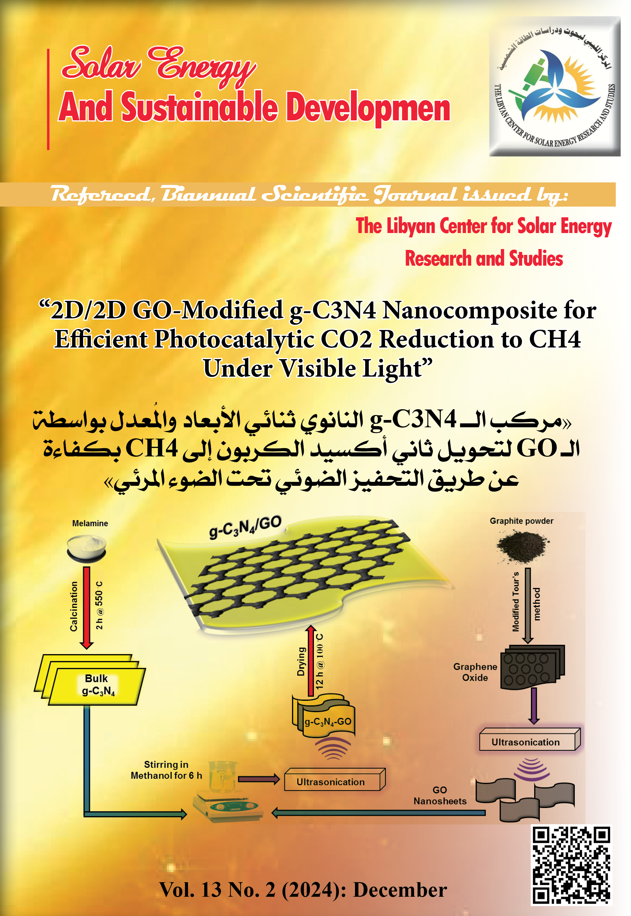2D/2D GO-Modified g-C3N4 Nanocomposite for Efficient Photocatalytic CO2 Reduction to CH4 Under Visible Light
DOI:
https://doi.org/10.51646/jsesd.v13i2.218Keywords:
Carbon-based nanomaterials, 2D/2D nanostructure, Photocatalytic CO2 reduction, CH4 production, Solar fuels.Abstract
Polymeric graphitic phase carbon nitride (g-C3N4) photocatalysts offer significant potential for CO2 photoreduction into solar fuels despite their efficiency restricted due to poor light response and recombination of photo-generated charges. This study focused on the modification of g-C3N4 by single-layered graphene oxide (GO) for enhancing photocatalytic CO2 reduction activity to form CH4. Well-designed 2D/2D GO-g-C3N4 was fabricated using facile thermal strategy. The hybrid photocatalyst exhibited improved CO2 photoreduction performance to produce CH4. The maximum CH4 yield of 25.61 µmol g-1 was achieved after 4 h of visible light illumination which represents about 25% enhancement compared to pristine g-C3N4. The incorporation of GO co-catalyst not only facilitates charge transfer but also offers an ample number of catalytic sites for CO2 adsorption. This work showcased the fabrication of g-C3N4-based binary photocatalyst with high CO2 photoreduction efficiency by coupling with metal-free co-catalyst.
Downloads
Metrics
References
E. Gong et al., “Solar fuels: research and development strategies to accelerate photocatalytic CO2 conversion into hydrocarbon fuels,” Energy Environ. Sci., vol. 15, no. 3, pp. 880–937, 2021, doi: 10.1039/d1ee02714j. DOI: https://doi.org/10.1039/D1EE02714J
G. Centi and C. Ampelli, “CO2 conversion to solar fuels and chemicals : Opening the new paths,” J. Energy Chem., vol. 91, pp. 680–683, 2024, doi: 10.1016/j.jechem.2024.01.021. DOI: https://doi.org/10.1016/j.jechem.2024.01.021
R. R. Ikreedeegh, M. Tahir, M. Madi, “Modified-TiO2 Nanotube Arrays as a Proficient Photo-Catalyst Nanomaterial for Energy and Environmental Applications,” Sol. Energy Sustain. Dev., vol. 13, no. 1, pp. 133–144, 2024, doi: https://doi.org/10.51646/jsesd.v13i1.196. DOI: https://doi.org/10.51646/jsesd.v13i1.196
V. H. Nguyen et al., “Towards artificial photosynthesis: Sustainable hydrogen utilization for photocatalytic reduction of CO2 to high-value renewable fuels,” Chem. Eng. J., vol. 402, no. June, p. 126184, 2020, doi: 10.1016/j.cej.2020.126184. DOI: https://doi.org/10.1016/j.cej.2020.126184
R. R. Ikreedeegh and M. Tahir, “A critical review in recent developments of metal-organic-frameworks (MOFs) with band engineering alteration for photocatalytic CO2 reduction to solar fuels,” J. CO2 Util., vol. 43, no. October 2020, p. 101381, 2021, doi: 10.1016/j.jcou.2020.101381. DOI: https://doi.org/10.1016/j.jcou.2020.101381
R. R. Ikreedeegh, M. A. Hossen, M. Tahir, and A. Abd Aziz, “A comprehensive review on anodic TiO2 nanotube arrays (TNTAs) and their composite photocatalysts for environmental and energy applications : Fundamentals , recent advances and applications,” Coord. Chem. Rev., vol. 499, no. October 2023, p. 215495, 2024, doi: 10.1016/j.ccr.2023.215495. DOI: https://doi.org/10.1016/j.ccr.2023.215495
M. A. Hossen et al., “Recent progress in TiO2-Based photocatalysts for conversion of CO2 to hydrocarbon fuels : A systematic review,” Results Eng., vol. 16, no. November, p. 100795, 2022, doi: 10.1016/j.rineng.2022.100795. DOI: https://doi.org/10.1016/j.rineng.2022.100795
M. A. Hossen et al., “A Comprehensive Review on Advances in TiO2 Nanotube (TNT)-Based Photocatalytic CO2 Reduction to Value-Added Products,” Energies, vol. 15, no. 22, p. 8751, 2022, doi: https://doi.org/10.3390/en15228751. DOI: https://doi.org/10.3390/en15228751
O. Ola and M. M. Maroto-valer, “Review of material design and reactor engineering on TiO2 photocatalysis for CO2 reduction,” "Journal Photochem. Photobiol. C Photochem. Rev., vol. 24, pp. 16–42, 2015, doi: 10.1016/j.jphotochemrev.2015.06.001. DOI: https://doi.org/10.1016/j.jphotochemrev.2015.06.001
A. A. Khan and M. Tahir, “Recent advancements in engineering approach towards design of photo-reactors for selective photocatalytic CO2 reduction to renewable fuels,” J. CO2 Util., vol. 29, no. May 2018, pp. 205–239, 2019, doi: 10.1016/j.jcou.2018.12.008. DOI: https://doi.org/10.1016/j.jcou.2018.12.008
D. Zhou, J. Zhang, Z. Jin, T. Di, and T. Wang, “Reduced graphene oxide assisted g-C3N4/rGO/NiAl-LDHs type II heterostructure with high performance photocatalytic CO2 reduction,” Chem. Eng. J., vol. 450, no. P3, p. 138108, 2022, doi: 10.1016/j.cej.2022.138108. DOI: https://doi.org/10.1016/j.cej.2022.138108
D. Xu, B. Cheng, W. Wang, C. Jiang, and J. Yu, “Ag2CrO4/g-C3N4/graphene oxide ternary nanocomposite Z-scheme photocatalyst with enhanced CO2 reduction activity,” Appl. Catal. B Environ., vol. 231, no. March, pp. 368–380, 2018, doi: 10.1016/j.apcatb.2018.03.036. DOI: https://doi.org/10.1016/j.apcatb.2018.03.036
R. Ramadhan and M. Tahir, “Facile fabrication of well-designed 2D/2D porous g-C3N4–GO nanocomposite for photocatalytic methane reforming (DRM) with CO2 towards enhanced syngas production under visible light,” Fuel, vol. 305, no. March, p. 121558, 2021, doi: 10.1016/j.fuel.2021.121558. DOI: https://doi.org/10.1016/j.fuel.2021.121558
C. Prasad, N. Madkhali, V. Govinda, H. Yeol, and I. Bahadur, “Recent progress on the development of g-C3N4 based composite material and their photocatalytic application of CO2 reductions,” J. Environ. Chem. Eng., vol. 11, no. 3, p. 109727, 2023, doi: 10.1016/j.jece.2023.109727. DOI: https://doi.org/10.1016/j.jece.2023.109727
Q. Guo et al., “Improved photocatalytic activity of porous ZnO nanosheets by thermal deposition graphene-like g-C3N4 for CO2 reduction with H2O vapor,” Appl. Surf. Sci., vol. 509, no. August 2019, p. 144773, 2020, doi: 10.1016/j.apsusc.2019.144773. DOI: https://doi.org/10.1016/j.apsusc.2019.144773
X. Li et al., “Local surface plasma resonance effect enhanced Z-scheme ZnO/Au /g-C3N4 film photocatalyst for reduction of CO2 to CO,” Appl. Catal. B Environ., vol. 283, no. October 2020, p. 119638, 2021, doi: 10.1016/j.apcatb.2020.119638. DOI: https://doi.org/10.1016/j.apcatb.2020.119638
Z. Li et al., “Boosting the photocatalytic CO2 reduction activity of g-C3N4 by acid modification,” Sep. Purif. Technol., vol. 338, no. January, p. 126577, 2024, doi: 10.1016/j.seppur.2024.126577. DOI: https://doi.org/10.1016/j.seppur.2024.126577
C. Prasad et al., “An overview of graphene oxide supported semiconductors based photocatalysts : Properties , synthesis and photocatalytic applications,” J. Mol. Liq., vol. 297, p. 111826, 2020, doi: 10.1016/j.molliq.2019.111826. DOI: https://doi.org/10.1016/j.molliq.2019.111826
M. A. Hossen et al., “Enhanced Photocatalytic CO2 Reduction to CH4 Using Novel Ternary Photocatalyst RGO/Au-TNTAs,” Energies, vol. 16, no. 14, 2023, doi: 10.3390/en16145404. DOI: https://doi.org/10.3390/en16145404
R. R. Ikreedeegh and M. Tahir, “Indirect Z-scheme heterojunction of NH2-MIL-125 (Ti) MOF/g-C3N4 nanocomposite with RGO solid electron mediator for efficient photocatalytic CO2 reduction to CO and CH4,” J. Environ. Chem. Eng., vol. 9, no. 4, p. 105600, 2021, doi: 10.1016/j.jece.2021.105600. DOI: https://doi.org/10.1016/j.jece.2021.105600
R. R. Ikreedeegh and M. Tahir, “Ternary nanocomposite of NH2-MIL-125(Ti) MOF-modified TiO2 nanotube arrays (TNTs) with GO electron mediator for enhanced photocatalytic conversion of CO2 to solar fuels under visible light,” J. Alloys Compd., vol. 969, no. October, p. 172465, 2023, doi: 10.1016/j.jallcom.2023.172465. DOI: https://doi.org/10.1016/j.jallcom.2023.172465
R. R. Ikreedeegh, S. Tasleem, and M. A. Hossen, “Facile fabrication of binary g-C3N4/NH2-MIL-125 (Ti) MOF nanocomposite with Z-scheme heterojunction for efficient photocatalytic H 2 production and CO 2 reduction under visible light,” Fuel, vol. 360, no. PC, p. 130561, 2024, doi: 10.1016/j.fuel.2023.130561. DOI: https://doi.org/10.1016/j.fuel.2023.130561
T. Kuilla, S. Bhadra, D. Yao, N. Hoon, S. Bose, and J. Hee, “Progress in Polymer Science Recent advances in graphene based polymer composites,” Prog. Polym. Sci., vol. 35, no. 11, pp. 1350–1375, 2010, doi: 10.1016/j.progpolymsci.2010.07.005. DOI: https://doi.org/10.1016/j.progpolymsci.2010.07.005
N. Cao and Y. Zhang, “Study of Reduced Graphene Oxide Preparation by Hummers ’ Method and Related Characterization,” J. Nanomater., vol. 2015, pp. 1–5, 2015, doi: 10.1155/2015/168125. DOI: https://doi.org/10.1155/2015/168125
J. Liu, T. Zhang, Z. Wang, G. Dawson, W. Chen, “Simple pyrolysis of urea into graphitic carbon nitride with recyclable adsorption and photocatalytic activity †,” J. Mater. Chem., vol. 21, pp. 14398–14401, 2011, doi: 10.1039/c1jm12620b. DOI: https://doi.org/10.1039/c1jm12620b
S. Tasleem and M. Tahir, “Constructing LaxCoyO3 Perovskite Anchored 3D g‑C3N4 Hollow Tube Heterojunction with Pro fi cient Interface Charge Separation for Stimulating Photocatalytic H2 Production,” Energy and Fuels, vol. 35, pp. 9727–9746, 2021, doi: 10.1021/acs.energyfuels.1c00512. DOI: https://doi.org/10.1021/acs.energyfuels.1c00512
R. R. Ikreedeegh and M. Tahir, “Photocatalytic CO2 reduction to CO and CH4 using g-C3N4/RGO on titania nanotube arrays (TNTAs),” J. Mater. Sci., vol. 56, no. 34, pp. 18989–19014, 2021, doi: 10.1007/s10853-021-06516-7. DOI: https://doi.org/10.1007/s10853-021-06516-7
R. R. Ikreedeegh, M. Tahir, “Titanium Carbide (TiC) MXene-Based Titanium Dioxide Composites for Energy and Environment Applications,” in Titanium Carbide MXenes: Synthesis, Characterization, Energy and Environmental Applications, Wiley, 2024, pp. 87–114. DOI: https://doi.org/10.1002/9783527838707.ch5
W. He et al., “Controllable morphology CoFe2O4/g-C3N4 p-n heterojunction photocatalysts with built-in electric field enhance photocatalytic performance,” Appl. Catal. B Environ., vol. 306, no. December 2021, p. 121107, 2022, doi: 10.1016/j.apcatb.2022.121107. DOI: https://doi.org/10.1016/j.apcatb.2022.121107
J. Li et al., “Ultrasonic-microwave assisted synthesis of GO/g-C3N4 composites for efficient photocatalytic H2 evolution,” Solid State Sci., vol. 97, no. August, p. 105990, 2019, doi: 10.1016/j.solidstatesciences.2019.105990. DOI: https://doi.org/10.1016/j.solidstatesciences.2019.105990
K. Prakash, S. Karuthapandian, and C. Cv, “Construction of Novel Metal ‑ Free Graphene Oxide / Graphitic Carbon Nitride Nanohybrids : A 2D–2D Amalgamation for the Effective Dedyeing of Waste Water,” J. Inorg. Organomet. Polym. Mater., vol. 31, no. 2, pp. 716–730, 2021, doi: 10.1007/s10904-020-01728-x. DOI: https://doi.org/10.1007/s10904-020-01728-x
Shalu Guptaa and Rakesh Kumar, “Enhanced photocatalytic performance of the N-rGO/g-C3N4 nanocomposite for efficient solar-driven water remediation,” Nanoscale, vol. 16, pp. 6109–6131, 2024, doi: 6109-6131. DOI: https://doi.org/10.1039/D3NR06203A

Downloads
Published
How to Cite
Issue
Section
License
Copyright (c) 2024 Solar Energy and Sustainable Development Journal

This work is licensed under a Creative Commons Attribution-NonCommercial 4.0 International License.













